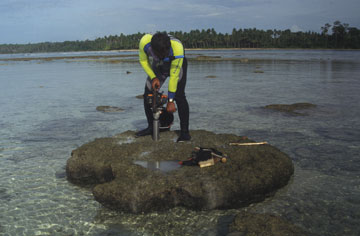|
NEWS NOTES — NEWS
Climate
Indian Ocean to face extreme weather
 |
| Researchers collected cores from fossil corals in the Mentawai Islands in western Indonesia to obtain detailed records of seasonal temperature and rainfall changes that occurred here thousands of years ago. Photograph is by M. Gagan. |
Not all regions of the world feel the effects of climate change equally. In Canada, for instance, global warming could make winters more pleasant. But new evidence from climate patterns of the distant past suggests that Indonesia and other regions bordering the Indian Ocean may experience devastating weather extremes, from powerful monsoons to lengthy droughts, which would threaten the livelihood of many who live there.
Indonesia, as well as parts of India, Australia and Africa, are affected by three weather systems: the Indian Ocean Dipole, the El Niño/Southern Oscillation (ENSO) and the Asian monsoon. The dipole involves a reversal of the sea-surface temperature gradient and winds along the equatorial region of the Indian Ocean, bringing cooler water to the east. Currently, this system results in floods in eastern Africa and drought in western Indonesia. ENSO, a Pacific Ocean system, can initiate the dipole effect, and cause the monsoon to weaken by cooling the ocean temperature near the Asian continent, thus reducing evaporation from the surrounding waters and leading to decreased rainfall.
Further complicating the picture is that climate simulations also show that the dipole can begin when the Asian monsoon strengthens the southeasterly trade winds and causes cooler water to rise in the eastern Indian Ocean. With a changing climate and evidence that the monsoon is strengthening independent of ENSO, however, researchers have had no solid basis for predicting these large weather cycles into the future.
In an effort to better understand these relationships, an international team of researchers, led by paleoclimatologist Nerilie Abram of Australian National University, decided to look back in time using fossil corals. Corals lay down bands of growth annually, not unlike tree rings. Oxygen isotope ratios and the ratio of strontium to calcium measured in the bands correspond to variations in rainfall, evaporation and sea-surface temperatures at the time the layers form, thus telling researchers when and to what extent the sea-surface temperatures changed (with cooler temperatures indicating a dipole), as well as the timing of major rainfalls (monsoons) and droughts (ENSO and dipoles).
When Abram and her colleagues assayed bands from 6,500- to 4,000-year-old fossil corals found off the coast of western Indonesia, they found that this was a period of a strong Asian monsoon and weak ENSO. When the monsoon gained in strength, Abram’s team reported Jan. 18 in Nature, the sea near western Indonesia stayed cooler longer, prompting the dipole to trigger longer and later droughts in that region than occur today. And although the historical data indicated that a strong ENSO year meant the monsoon would be weak, recent evidence from historical climate data suggests monsoons are “trumping” the tempering effect of ENSO, encouraged by the greenhouse effect. That means that longer periods of drought could be in the future for much of Indonesia and parts of Australia, while India and other regions could be bombarded with stronger tropical storms.
And there’s no guaranteeing that monsoons and droughts will get stronger at a slow and steady pace. It’s possible, Abram says, that the weather systems could reach a tipping point. “These changes might not happen gradually,” she says. “They might happen quite suddenly.”
Julia Cole, a climate scientist at the University of Arizona, says the implications from this study are startling. “This paper shows that the system we think we know and understand very well has behaved very differently in the past.” And that’s not good news for the people living in impoverished parts of Indonesia and other regions surrounding the Indian Ocean, who would likely suffer the harshest droughts and accompanying wildfires and agricultural disruption.

 Subscribe
Subscribe


